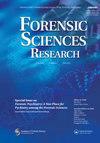Sequence variations of 58 STRs and 94 SNPs in Northeastern Xibe with ForenSeq™ DNA signature prep kit
IF 1.8
4区 医学
Q3 MEDICINE, LEGAL
引用次数: 0
Abstract
Massively parallel sequencing (MPS) technology has already shown many advantages in forensic DNA typing. In this study, the repeat region (RR) and flanking region (FR) variations were detected at 58 short tandem repeats (STRs) by MPS, which could increase allelic diversity (34.59%) and gene diversity (3.95%) compared with the capillary electrophoresis (CE) method. Six novel RR variants were identified at 5 STRs, and eleven FR variants were found at 8 STRs. Concordance amounted to 99.96% (4598 out of 4600 alleles) between ForenSeq DNA Signature Prep Kit and CE kits, and discordance was due to bioinformatic misinterpretation at DXS7132. Additionally, allele frequencies and forensic parameters of 94 identity-informative single nucleotide polymorphisms (iiSNPs) provided a reference dataset, which held a higher power of discrimination (1–3.4825 × 10−35). A total of 29 FR variants were found at 24 target iiSNPs. The power of the system effectiveness with the combined 27 autosomal STRs by sequence and 94 iiSNPs was added more substantially than that of a single type of marker alone, such as the combined power of discrimination (CPD) and the combined power of exclusion (CPE) achieving 1–7.1358 × 10−65 and 1–4.4803 × 10−21, respectively. Population structure analyses with iiSNPs and additional ancestry-informative SNPs (aiSNPs) demonstrated that Chinese Xibe in the northeast was one of the East Asian populations. At the genetic level, Northeastern Xibe is close to populations where they live, such as Han Chinese and other ethnic minority groups.使用 ForenSeq™ DNA 特征预处理试剂盒分析锡伯族东北部 58 个 STR 和 94 个 SNP 的序列变化
大规模平行测序(MPS)技术在法医DNA分型中已经显示出许多优势。本研究利用MPS检测了58个短串联重复序列(STRs)的重复区(RR)和侧翼区(FR)变异,与毛细管电泳(CE)相比,该方法可提高等位基因多样性(34.59%)和基因多样性(3.95%)。在5个str中发现6个新的RR变异,在8个str中发现11个FR变异。法医DNA签名准备试剂盒与CE试剂盒之间的一致性达99.96%(4600个等位基因中有4598个),不一致是由于DXS7132的生物信息学误解。此外,94个身份信息单核苷酸多态性(iiSNPs)的等位基因频率和法医学参数提供了一个具有较高判别能力(1-3.4825 × 10−35)的参考数据集。在24个目标iiSNPs中共发现29个FR变异。与单独使用单个标记相比,将27个常染色体STRs序列和94个iiSNPs组合在一起的系统有效性增强更大,如联合辨别能力(CPD)和联合排除能力(CPE)分别达到1-7.1358 × 10−65和1-4.4803 × 10−21。利用iiSNPs和附加遗传信息性snp (aiSNPs)进行的种群结构分析表明,中国东北锡伯族是东亚人群之一。在遗传水平上,锡伯族东北部与他们居住的人群(如汉族和其他少数民族)接近。
本文章由计算机程序翻译,如有差异,请以英文原文为准。
求助全文
约1分钟内获得全文
求助全文

 求助内容:
求助内容: 应助结果提醒方式:
应助结果提醒方式:


